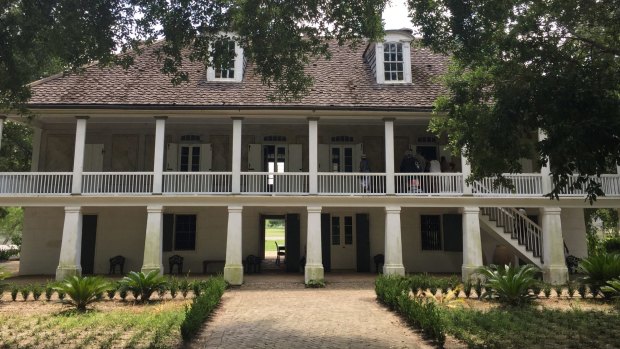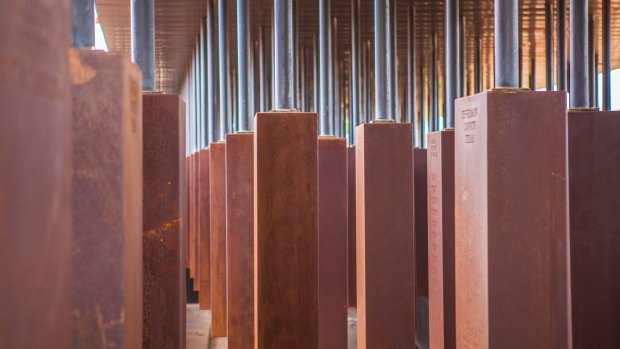This was published 4 years ago
The completely appalling tourist attraction you must visit in the US
By Lance Richardson

The Whitney Plantation.Credit: Bill Leiser/Wikipedia
The remarkable house at Whitney Plantation stands on the banks of the Mississippi River. Leading up to it are two rows of live oaks dripping with Spanish moss, which creates a natural tunnel and picturesque frame. The "big house" is at the end of the tunnel: French Creole style, with two white columned floors and a wide verandah. As habitations go, it is grand and majestic. But it is also, when you look closer, completely appalling. Like many places in Louisiana, the Whitney was built on the backs of enslaved people.
This is one of the many things I learn on a walk around the plantation: the more than 12 million Africans who were stolen from their homelands and carried across the ocean to America were not "slaves," but "enslaved people". The subtle shift is important. Slavery was not who they were; it was a condition forcibly inflicted on them by others, here, in this alien place.
I arrive at the Whitney Plantation, which is open to the public by guided tour only, on a steamy Thursday afternoon. A small group of us pick up umbrellas — the sun is blazing — and follow a man named Ali onto the grounds.

The National Memorial for Peace and Justice Montgomery Alabama.
"We don't expect anybody to come as an expert on slavery," he says with a thick Louisiana accent. "Don't learn enough about it in our school system for that."
For almost two hours, Ali explains how black bodies transformed an inhospitable swamp into productive sugarcane fields. It was the deadliest form of farming in the world, and the average life expectancy was just 10 years. "Come when 10?" Ali says. "Dead when 20." He is direct and unsparing in his descriptions of an economic model that reduced human beings to the status of chattel.
The Whitney is fascinating, often shocking - bodies have been exhumed here with the tendons worked out of their joints through brute hard labor. But for me it is background, just part of the story. My main destination is 500 kilometres away.
Slavery was abolished in America in 1865, when congress finally ratified the Thirteenth Amendment. Still, people tend to be disinclined to give up prejudices just because the federal government tells them they're wrong. In the South, in the first two years after the end of the American Civil War, thousands of African Americans were murdered for exerting their newly-won rights. These murders — sometimes called "racial terror lynchings" — then continued for decades as a new social hierarchy was constructed based on ideas of segregation and white supremacy. In other words, the slavery seen at the Whitney Plantation did not truly disappear; it simply evolved into something else.
That something else, and the "racial terror lynchings," are the focus of a poignant memorial which opened last year in Alabama. Leaving the Whitney and Louisiana, I drive north-east for five hours through bayou and forest. Eventually I reach Montgomery, a town famously associated with the modern civil rights movement. Here is where Rosa Parks refused to give up her seat on the bus for a white man in 1955. Here is where a young reverend named Martin Luther King, Jr. organised a bus boycott, which led the Supreme Court to demand integration, and thrust King onto a national stage.
The National Memorial for Peace and Justice sits in the centre of Montgomery, high on a green hillock. It was created by Bryan Stevenson, founder of the Equal Justice Initiative, a non-profit which provides legal services to incarcerated people who can't afford a lawyer. (They have more work than they can handle.) The memorial is based on years of research in public archives by Stevenson's staff — years of research that uncovered evidence of almost 4400 lynchings perpetrated "by groups of two to over 10,000 white people".
Approaching the hill is to be confronted almost immediately with a breathtaking sight. On the ascending pathway, I pause — as do a crowd of school children — in front of Africans in chains. There are shackles around their necks, and their faces are contorted in confused misery. The Ghanaian artist who made these graphic statues, Kwame Akoto-Bamfo, has no interest in consoling: he means to shake you awake.
The rest of the Memorial may be less visually abrupt, but it disturbs me no less for its symbolic implications. At the top of the hill is a square cloister, which begins at ground level and then spirals down into the earth. On the walkway are 800 steel columns, each one engraved with the names of lynching victims from various counties, including the one where the Whitney is located. As I walk down the spiral, the columns remain fixed in place, so I must increasingly crane my neck upwards to make out the names. Eventually, like a punch to the gut, I realise that the columns are dangling overhead. As Billie Holiday once sang, "Black bodies swinging in the southern breeze, Strange fruit hanging from the poplar trees." Through the power of creative architecture, the memorial makes a visitor a witness.
It does this at the same moment it is confronting you with incomprehensible stories, etched into the walls: "Frank Dodd was lynched in DeWitt, Arkansas, in 1916 for annoying a white woman." Mary Turner, meanwhile, "was lynched, with her unborn child, at Folsom Bridge at the Brooks-Lowndes County line in George in 1918 for complaining about the recent lynching of her husband, Hayes Turner".
As I emerge back into the sunlight, the true purpose of the National Memorial for Peace and Justice becomes clear. In a "Memorial Park", replicas of the 800 steel columns are lined up waiting to be collected. Beginning next year, each county will have an opportunity to acknowledge and confront its own complicity in the historical violence. What the Equal Justice Initiative has created is a stunning monument meant to trigger a national conversation — or a national reckoning.
The need for this reckoning is only reinforced at an accompanying Legacy Museum, which brings the story up to date. Slavery is over; Jim Crow is over; lynchings are over; but is prejudice over? The museum argues no. It illustrates ways in which the American criminal justice system is tainted by an implicit bias that disproportionately targets people of colour. Whether police brutality or unequal incarceration rates — "one in three black baby boys is expected to go to jail or prison," a plaque claims — the evidence is troubling.
As I walk around, one image stops me cold. "Incarcerated men are forced to labour in the fields at the Louisiana State Penitentiary, formerly a slave plantation," the caption reads. The photograph, showing a line of black men being directed by a white man on a horse, could have been taken at the Whitney. And yet it was taken in 2011.
TRIP NOTES
MORE
Lance Richardson travelled at his own expense.
DRIVE
The Whitney Plantation, in Wallace, Louisiana, is an easy one-hour drive west from New Orleans. Montgomery, Alabama, is a five-hour drive north-east from New Orleans, or just two hours south from Atlanta, which is a major transportation hub for Delta Airlines.
TOUR
The Whitney Plantation is open every day except Tuesday, and by guided tour only. The tours last for about 90 minutes and are offered hourly. Cost is $23 per adult. See whitneyplantation.com
The National Memorial for Peace and Justice is also open every day except Tuesday. Last entry is at 4:30pm, and tickets are $5 per adult. Tickets to the nearby Legacy Museum are $8 per adult. A combination ticket is also available. Book ahead, particularly for the museum. See museumandmemorial.eji.org
FIVE MORE SIGHTS IN MONTGOMERY, ALABAMA
1 THE CIVIL RIGHTS MEMORIAL
Resembling a giant granite clock, the Civil Rights Memorial lists the names of leaders (and martyrs) who have fought to make America a more equal place. A quote from Martin Luther King Jr. — "Until justice rolls down like waters and righteousness like a mighty stream" — is set in a waterfall.
2 MARTIN LUTHER KING'S HOME
The parsonage that Martin Luther King Jr. once called home, and that was bombed by white supremacists in 1956, is at 309 South Jackson Street. It has since been restored and now features a small museum.
3THE FREEDOM RIDES MUSEUM
This commemorates the site of a 1961 anti-segregation protest and is housed in an old Greyhound bus station. It is part of the US Civil Rights Trail which crosses 14 states.
4. ROSA PARKS MUSEUM
The stop where Rosa Parks climbed on a bus and changed the course of history is marked at Court Square. Nearby is the Rosa Parks Museum, detailing the boycott and its aftermath.
5 FIRST WHITE HOUSE OF THE CONFEDERACY"
During the Civil War, the Confederacy's only president, Jefferson Davis, made Montgomery his first capital. The "First White House of the Confederacy" survives at 644 Washington Avenue, complete with original period pieces and a dubious narrative of Jefferson Davis as a "patriot".
Sign up for the Traveller Deals newsletter
Get exclusive travel deals delivered straight to your inbox. Sign up now.